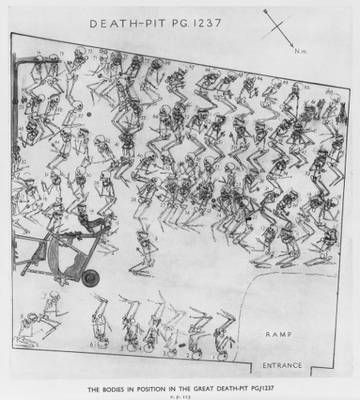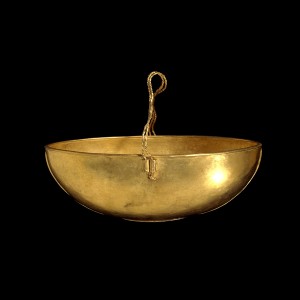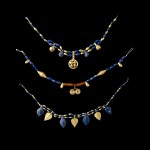 In 1927, Leonard Woolley began digging human remains from a vast gilded killing field at Tell al-Muqayyar in Iraq, a place better known to most today by its biblical name: Ur. Woolley, the son of an Anglican curate and a very skilled excavator, had made a study of Ur, a city-state that rose to prominence along the Euphrates in the third millennium B.C. With financing from both the British Museum and Penn Museum in Philadelphia, Woolley had documented Ur’s great ziggurat–a stepped pyramid made of bricks–and pored over its temples and other monumental buildings. Digging its tombs seemed the logical next step.
In 1927, Leonard Woolley began digging human remains from a vast gilded killing field at Tell al-Muqayyar in Iraq, a place better known to most today by its biblical name: Ur. Woolley, the son of an Anglican curate and a very skilled excavator, had made a study of Ur, a city-state that rose to prominence along the Euphrates in the third millennium B.C. With financing from both the British Museum and Penn Museum in Philadelphia, Woolley had documented Ur’s great ziggurat–a stepped pyramid made of bricks–and pored over its temples and other monumental buildings. Digging its tombs seemed the logical next step.
Little prepared Woolley, however, for the haunting death scenes he soon uncovered. In 16 royal tombs, he and his workmen found two mass graves, or “death-pits” as Woolley dubbed them, containing gold-and silver-adorned skeletons. One pit, PG 789, brimmed with the bodies of 63 individuals. The second, known as the Great Death-Pit, PG 1237, revealed rows of skeletons, almost entirely female, 74 individuals in all. Many of the women had gone to their grave wearing gold ribbons, gold wreathes, gold necklaces with lapis lazuli beads. Some were arranged in overlapping rows, so that the head of one lay companionably on the legs or feet of another.
Woolley concluded that the bodies in PG 1237 belonged to court retainers who were sacrificed to serve their royal masters in the next world. But he puzzled over the manner of their death.  “The bones,” he wrote in Ur of the Chaldees, “are too crushed and too decayed to show any cause of death.” So Woolley searched the pit itself for some sign of violent struggle. But he could find none. Finally, he settled on an interpretation. The women, he suggested, had downed a poisonous or soporific drug from one of the cups littering the grave and then laid down quietly in tidy rows to await death.
“The bones,” he wrote in Ur of the Chaldees, “are too crushed and too decayed to show any cause of death.” So Woolley searched the pit itself for some sign of violent struggle. But he could find none. Finally, he settled on an interpretation. The women, he suggested, had downed a poisonous or soporific drug from one of the cups littering the grave and then laid down quietly in tidy rows to await death.
For nearly 80 years most archaeologists accepted Woolley’s interpretation. But last month a team led by Penn Museum archaeologist Aubrey Baadsgaard published new forensic evidence in the journal Antiquity that reveals a more sinister and strange scenario than Woolley ever imagined.
Baadsgaard and her colleagues selected two of the damaged skulls that Woolley excavated from Ur, one from the Great Death Pit, the other from the second largest grave, PG 789, and arranged to have them CT-scanned at the Hospital of the University of Pennsylvania. Then the team pored over the scans. Dental evidence and other data revealed that the skull from the Great Death Pit belonged to a young female in her late teens or early twenties. The other skull came from a young man in the prime of life, aged 25 to 30, who was outfitted with a copper helmet.
Both likely died in the same murderous way. Someone dealt them hard, fatal blows to the head with a heavy weapon that possessed what the authors call “a small pointed striking end.” And in a lovely piece of archaeological sleuthing, the authors appear to have found the very kind of weapon that did them in: a copper battleaxe excavated from the Royal Cemetery and equipped with a long sharp lethal spike.
 But there’s more to the study. Baadsgaard and her colleagues also detected traces of heating or burning on the female skull, as well as small hardened droplets of a metallic substance that later proved to be mercury sulphide, commonly known as cinnabar. In Eurasia, early societies discovered many ways of preserving animal and human flesh from decomposition. Some in the ancient Near East used heating and smoking to preserve the bodies of the royal dead. In China, powerful families sometimes mummified the bodies of important people in a mercury bath. It is entirely possible, notes the Penn Museum team, that the people of Ur attempted to mummify all the retainers “to reduce decay while elaborate and lengthy funeral rights were performed before burying deceased bodies.”
But there’s more to the study. Baadsgaard and her colleagues also detected traces of heating or burning on the female skull, as well as small hardened droplets of a metallic substance that later proved to be mercury sulphide, commonly known as cinnabar. In Eurasia, early societies discovered many ways of preserving animal and human flesh from decomposition. Some in the ancient Near East used heating and smoking to preserve the bodies of the royal dead. In China, powerful families sometimes mummified the bodies of important people in a mercury bath. It is entirely possible, notes the Penn Museum team, that the people of Ur attempted to mummify all the retainers “to reduce decay while elaborate and lengthy funeral rights were performed before burying deceased bodies.”
All this, of course, is a far cry from Woolley’s bloodless, beautiful, sleepy deaths. In Ur, royal families ordered the violent deaths of dozens of young courtiers and servants so that they might continue to serve dead kings and queens in the afterlife.
So enough complaining about the Royal Wedding. Long before there was a Kate Middleton, long before there was a Princess Diana coyly courting the cameras and a Bertie Windsor wrestling with a stammer, there were royal families whose sense of entitlement truly knew no bounds.
Photos and Illustrations: Top: Plan of the Great Death-Pit, courtesy Iraq’s Ancient Past, Penn Museum. Middle: Gold Bowl from the Royal Cemetery of Ur, courtesy Trustees of the British Museum. Bottom: Beads and pendants from the Royal Cemetery of Ur, courtesy Trustees of the British Museum.
Heather.. I would like to receive your articles every Fri? or whenever they are. I
was subscribed, but no longer get them.
sallieanddoug@yahoo.com Sallie
Hi Sallie:
Thanks so much for the note. If you go to our homepage and look at the top of the right-hand column, just below “Our Word of Honor,” you”ll see a red and blue “Subscribe” button. If you click on that, you’ll see a tab at the top called “Email.” Click on that, and then click on the little icon that says FeedBlitz, and you will be able to subscribe there. You’ll get all the posts on LWON that way. We changed over to this system a few months ago, and I know that we lost some subscribers. I’m awfully sorry to hear that you were one of them! Thanks for persisting!
Best
Heather
Oh heck, I shiver down my spine. Ancient beliefs really was impossible. And to think that there is no human rights activist or no autopsy during that times. Glad I was born later.